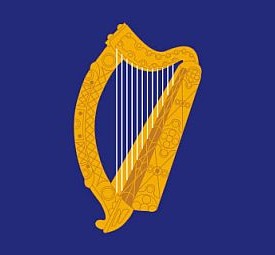Flags of Ireland
As with many nations, there are a number of flags that represent Ireland at home and abroad. The flags represented here are mostly those of the nation of Ireland (often referred to as the Republic of Ireland) whilst Northern Ireland has also used flags to represent itself although they are not usually internationally recognised.
The national flag of Ireland (Irish: An Bhratach Náisiúnta), also known as the tricolour, is a vertical tricolour of green (at the hoist), white, and orange. The flag proportion is 1:2 (length twice width). The green is representative of the older Gaelic tradition while the orange represents the supporters of William of Orange. The white in the centre signifies a lasting truce between the two cultures.
The tricolour is regarded by many nationalists as the national flag of the whole of island of Ireland. Thus it is flown (often controversially) by many nationalists in Northern Ireland as well as by the Gaelic Athletic Association. In international politics, the Tricolour is the official flag of the Republic of Ireland.
The ‘Northern Ireland Flag’ was used from 1953-1972 by the devolved Stormont government to represent the government of Northern Ireland. Therefore, when the government of Northern Ireland was suspended in March 1972, its arms and flag “officially” disappeared. It is still used by some sporting bodies.
Historically, the island has been represented by a number of other flags, including the Saint Patrick’s cross, and the Flag of the Four Provinces of Ireland. The President’s Flag includes the historic symbol of Ireland, the harp, to create a distinguished symbol to represent the position.
The Flag of the Four Provinces includes the flags representing the ancient provincial areas of (clockwise from top right) Ulster, Munster, Leinster and Connacht. The provincial structure of Rugby, Gaelic Games and, increasingly, soccer in Ireland is based upon a provincial structure.
- Flag of the President of Ireland
- An Bhratach Náisiúnta
- Northern Ireland Flag until 1972
- Four Provinces Flag
- Cross of Saint Patrick






